Get free scan and check if your device is infected.
Remove it nowTo use full-featured product, you have to purchase a license for Combo Cleaner. Seven days free trial available. Combo Cleaner is owned and operated by RCS LT, the parent company of PCRisk.com.
What is the Basbanke trojan?
Basbanke, also known as Coybot, is a malicious program classified as a Trojan (specifically, a banking Trojan). It targets Android operating systems and is used to to extract/exfiltrate users' banking account log-in credentials.
Basbanke has been observed targeting certain banking applications of Spain, Portugal, and Brazil and, most notably, the multinational Banco Santander banking app. The Basbanke Trojan is high-risk malware that poses a significant threat to users' finances and privacy.
During latest research, Basbanke Trojan was distributed under the guise a security tool for a specific bank (Santander). Following successful infiltration, and once opened, the malware requests certain permissions. If these are granted, the Trojan can then perform various actions without users' consent (i.e., it can perform clicks/taps without user input).
For example, Basbanke can then grant itself more permissions, and more control over the infected device. When users access the legitimate banking app (e.g. Santander) or have the application force-opened, the Basbanke Trojan overlays it. Therefore, users are presented with a fake screen that imitates the genuine app.
Log-in credentials (e.g. usernames, passwords, passcodes, etc.) entered through this phishing screen are sent to the cyber criminals' Control and Command (C&C) server. Basbanke infections can enable criminals to hijack victims' bank accounts and misuse them to make fraudulent transactions and/or to make online purchases.
To summarize, Basbanke can lead to significant financial loss and other serious issues. If it is known/suspected that the Basbanke Trojan (or other malware) has already infected the system, you are strongly advised to eliminate it immediately.

| Name | Coybot malware |
| Threat Type | Android malware, malicious application, unwanted application. |
| Related Domains | es-atualiza[.]com |
| Detection Names (es-atualiza[.]com) |
Kaspersky (Malware), CRDF (Malicious), CyRadar (Malicious), ESET (Phishing), Full List (VirusTotal). |
| Detection Names | Avast-Mobile (APK:RepSandbox [Trj]), DrWeb (Android.BankBot.2299), ESET-NOD32 (A Variant Of Android/Spy.Banker.AOR), Kaspersky (HEUR:Trojan-Banker.AndroidOS.Basbanke.), Full List (VirusTotal). |
| Symptoms | The device is running slow, system settings are modified without users' permission, dubious applications appear, data and battery usage is increased significantly, browsers redirect to bogus websites, intrusive advertisements are delivered. |
| Distribution methods | Infected email attachments, malicious online advertisements, social engineering, deceptive applications, scam websites. |
| Damage | Stolen personal information (private messages, logins/passwords, etc.), decreased device performance, battery is drained quickly, decreased internet speed, significant data loss, monetary loss, stolen identities (malicious apps might abuse communication apps). |
| Malware Removal (Windows) |
To eliminate possible malware infections, scan your computer with legitimate antivirus software. Our security researchers recommend using Combo Cleaner. Download Combo CleanerTo use full-featured product, you have to purchase a license for Combo Cleaner. 7 days free trial available. Combo Cleaner is owned and operated by RCS LT, the parent company of PCRisk.com. |
Joker, SpyMax, Anubis, Ginp and Eventbot are some examples of other malicious programs designed to target Android operating systems. While they operate differently and possess varied functionalities, their purpose is identical: to generate revenue for the cyber criminals using them.
To ensure device integrity and user safety, it is crucial to remove malware infections without delay.
How did Basbanke infiltrate my device?
As mentioned, Basbanke has been observed being disguised as security tools for banking applications such as Santander. These apps were distributed through fake banking websites (e.g. es-atualiza[.]com), however, other disguises and other proliferation methods are highly likely.
In general, malware is proliferated through loader/backdoor Trojans, spam campaigns, illegal activation tools ("cracks"), fake updaters and untrusted download channels. Some Trojans are capable of causing chain infections (i.e., download/install additional malware).
The term "spam campaign" is used to define a large scale operation, during which scam emails are sent by the thousand. These deceptive messages are typically presented as "official", "important", "urgent" and similar. They have infectious files attached to them or, alternatively, contain download links to such content.
Malicious files can be in various formats such as archives (RAR, ZIP, etc.), executables (.exe, .run, etc.), Microsoft Office and PDF documents, JavaScript. When they are executed, run, or otherwise opened, the infection process is triggered. Illegal activation ("cracking") tools can download/install malware, rather than activating the licensed products.
Rogue updaters cause infections by exploiting flaws of outdated products and/or simply by installing malware, rather than the promised updates.
Dubious download sources such as unofficial and free file-hosting websites, Peer-to-Peer sharing networks (BitTorrent, eMule, Gnutella, etc.) and other third party downloaders can offer malware, disguised as or bundled with normal content.
How to avoid installation of malware
You are strongly advised against opening suspicious and/or irrelevant emails, especially those with any attachments or links found in them, as doing so can result in high-risk infection. Use only official and verified download channels.
Activate and update products with tools/functions provided by legitimate developers, since illegal activation tools ("cracks") and third party updaters are often used to proliferate malware. Have reputable anti-virus/anti-spyware installed. This software must be kept up to date, used to run regular system scans and to remove detected threats/issues.
Quick menu:
- Introduction
- How to delete browsing history from the Chrome web browser?
- How to disable browser notifications in the Chrome web browser?
- How to reset the Chrome web browser?
- How to delete browsing history from the Firefox web browser?
- How to disable browser notifications in the Firefox web browser?
- How to reset the Firefox web browser?
- How to uninstall potentially unwanted and/or malicious applications?
- How to boot the Android device in "Safe Mode"?
- How to check the battery usage of various applications?
- How to check the data usage of various applications?
- How to install the latest software updates?
- How to reset the system to its default state?
- How to disable applications that have administrator privileges?
Delete browsing history from the Chrome web browser:
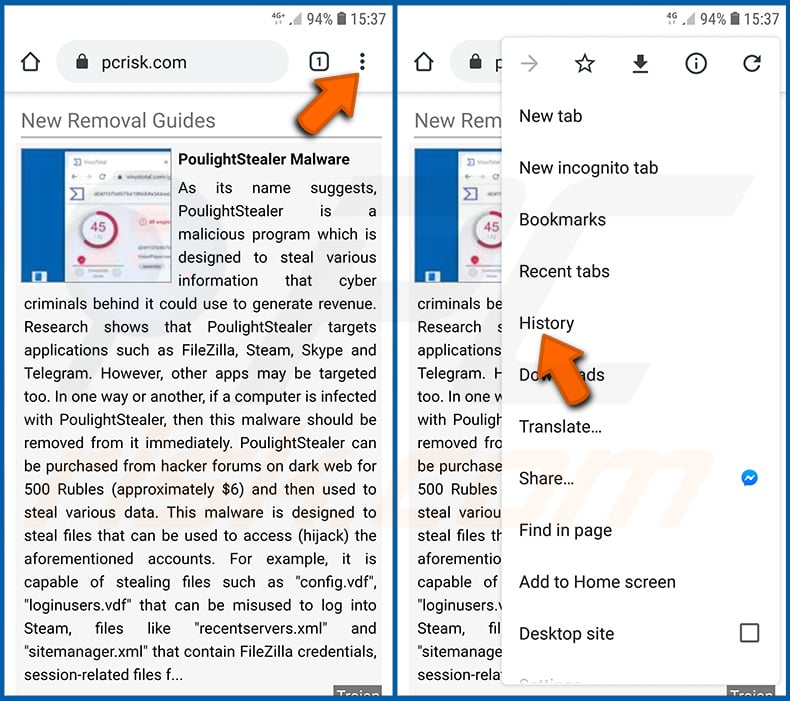
Tap the "Menu" button (three dots on the right-upper corner of the screen) and select "History" in the opened drop-down menu.

Tap "Clear browsing data", select "ADVANCED" tab, choose the time range and data types you want to delete and tap "Clear data".
Disable browser notifications in the Chrome web browser:
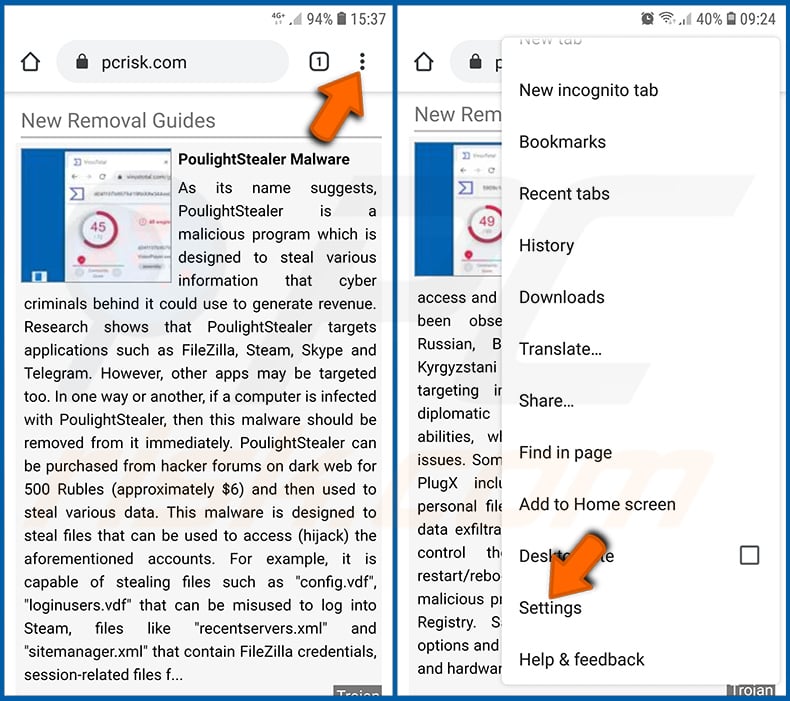
Tap the "Menu" button (three dots on the right-upper corner of the screen) and select "Settings" in the opened drop-down menu.
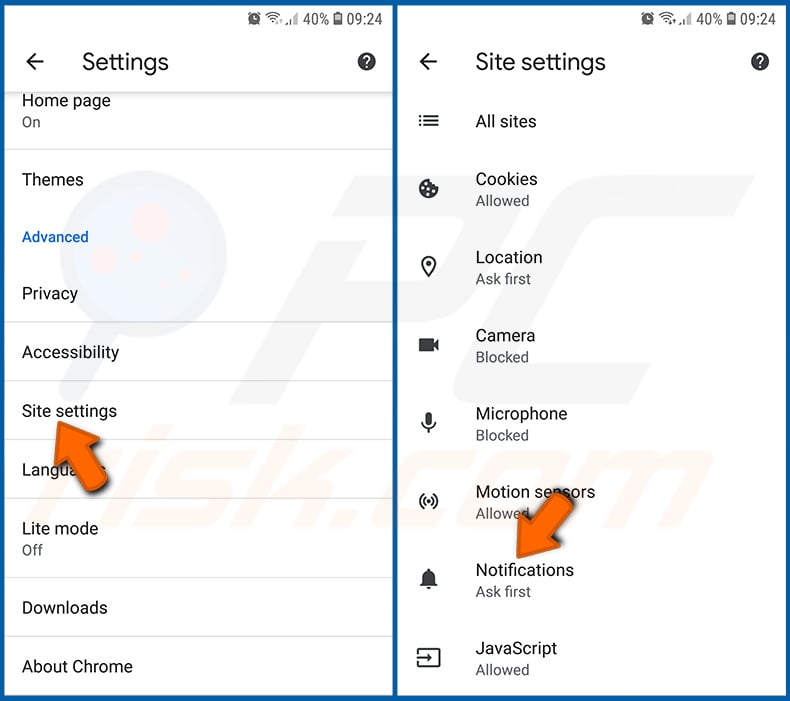
Scroll down until you see "Site settings" option and tap it. Scroll down until you see "Notifications" option and tap it.
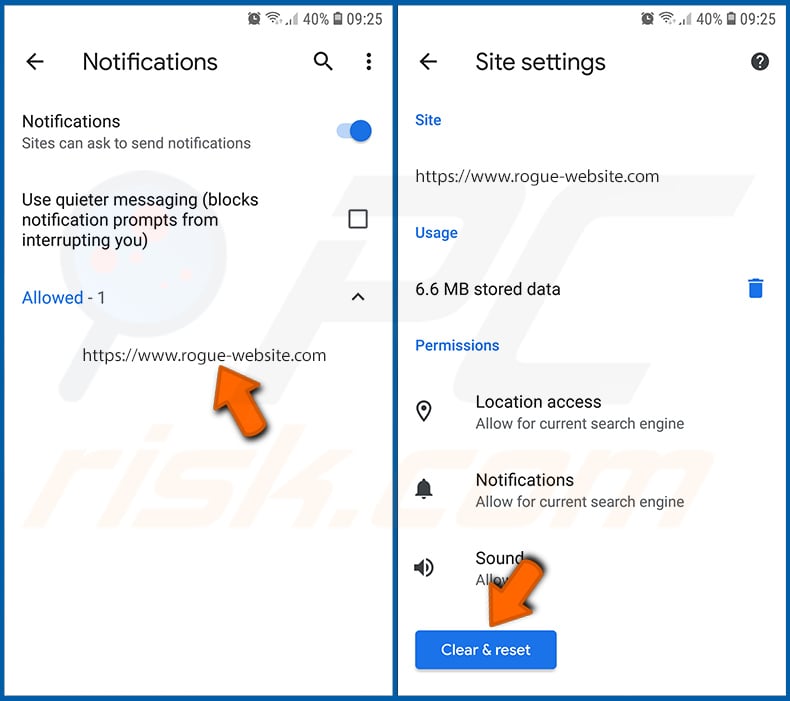
Find the websites that deliver browser notifications, tap on them and click "Clear & reset". This will remove permissions granted for these websites to deliver notifications, however, once you revisit the same site, it may ask for permission again.
You can choose whether to give these permissions (if you choose to decline, the website will go to the "Blocked" section and will no longer ask for permission).
Reset the Chrome web browser:
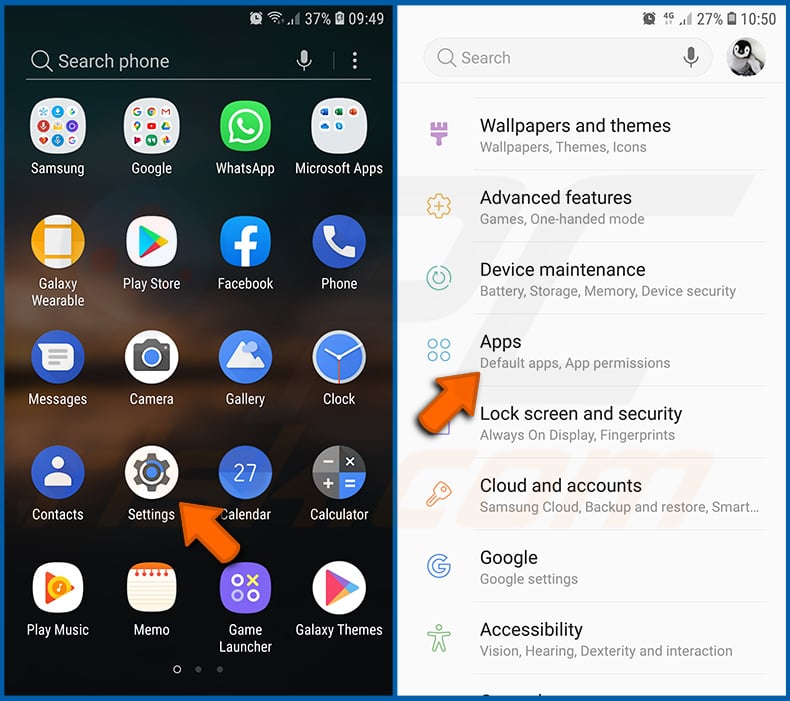
Go to "Settings", scroll down until you see "Apps" and tap it.
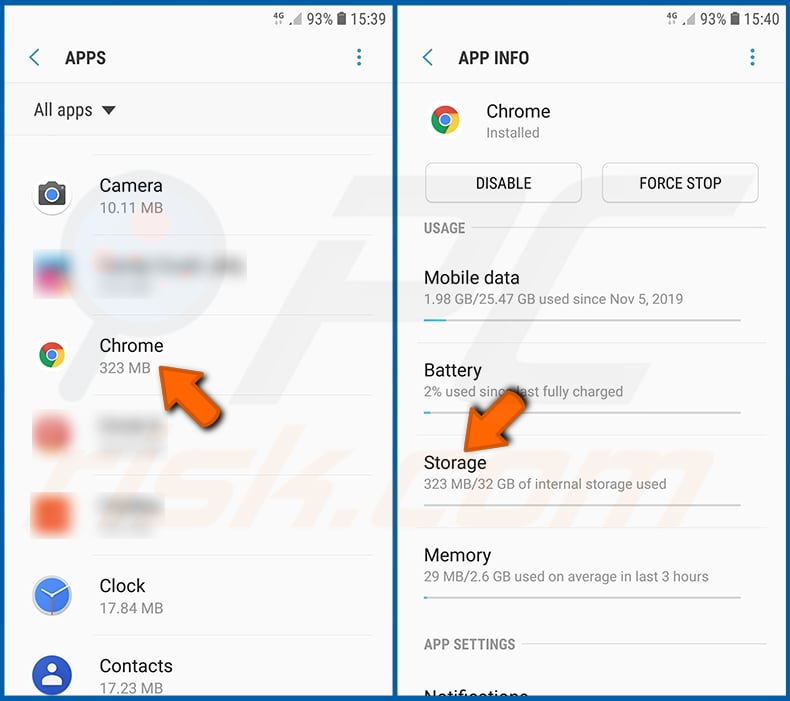
Scroll down until you find "Chrome" application, select it and tap "Storage" option.
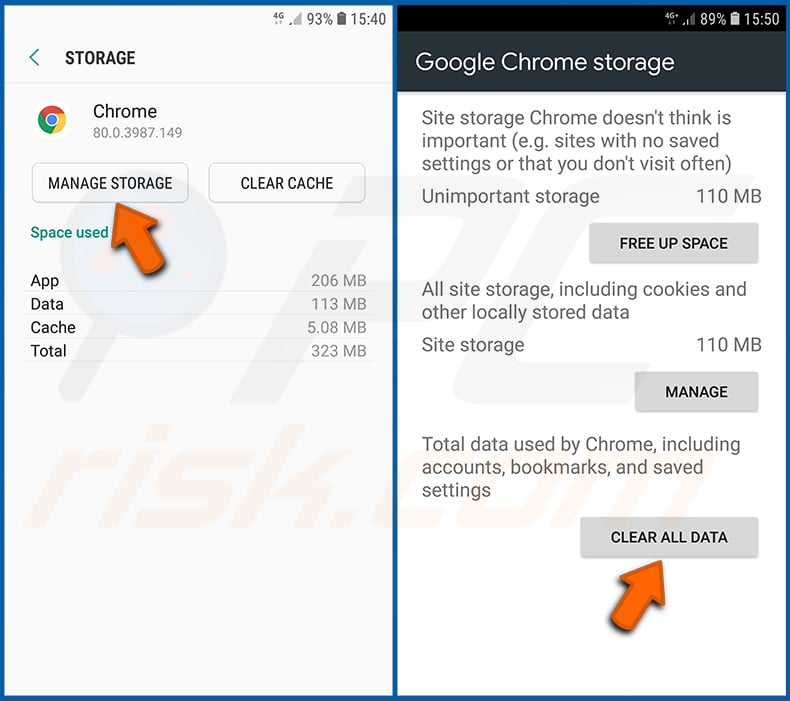
Tap "MANAGE STORAGE", and then "CLEAR ALL DATA" and confirm the action by taping "OK". Note that resetting the browser will eliminate all data stored. Therefore, all saved logins/passwords, browsing history, non-default settings and other data will be deleted. You will also have to re-login into all websites.
Delete browsing history from the Firefox web browser:
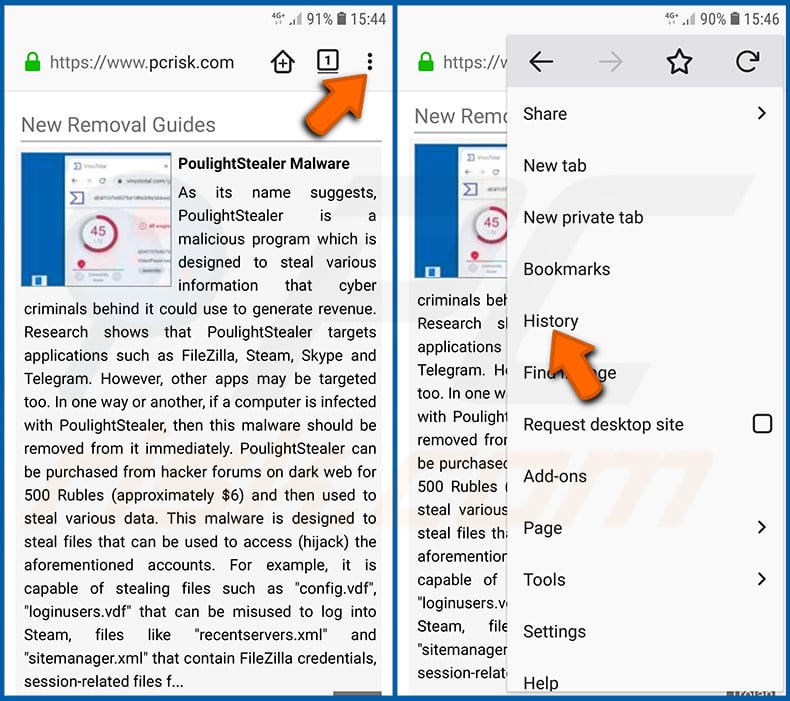
Tap the "Menu" button (three dots on the right-upper corner of the screen) and select "History" in the opened drop-down menu.
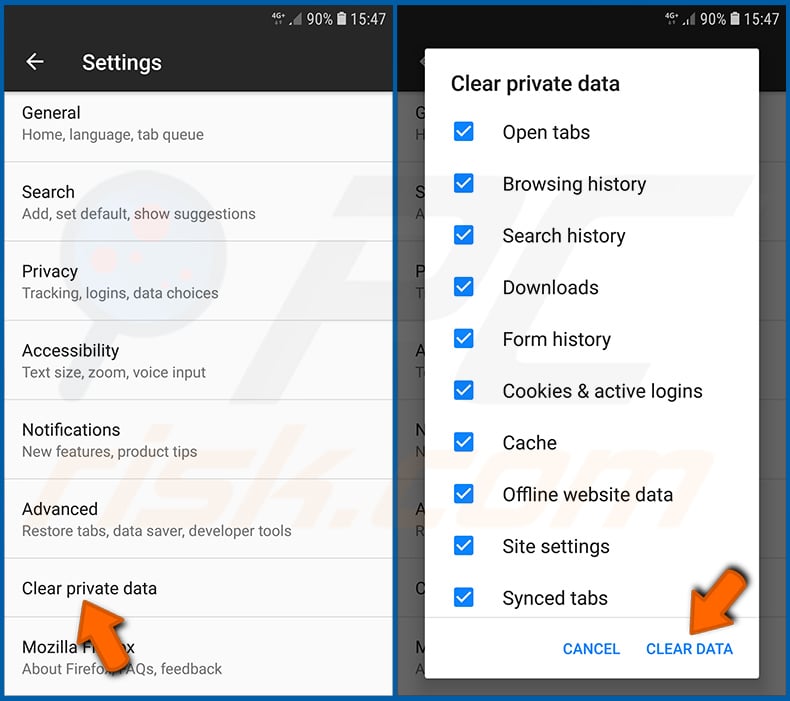
Scroll down until you see "Clear private data" and tap it. Select data types you want to remove and tap "CLEAR DATA".
Disable browser notifications in the Firefox web browser:
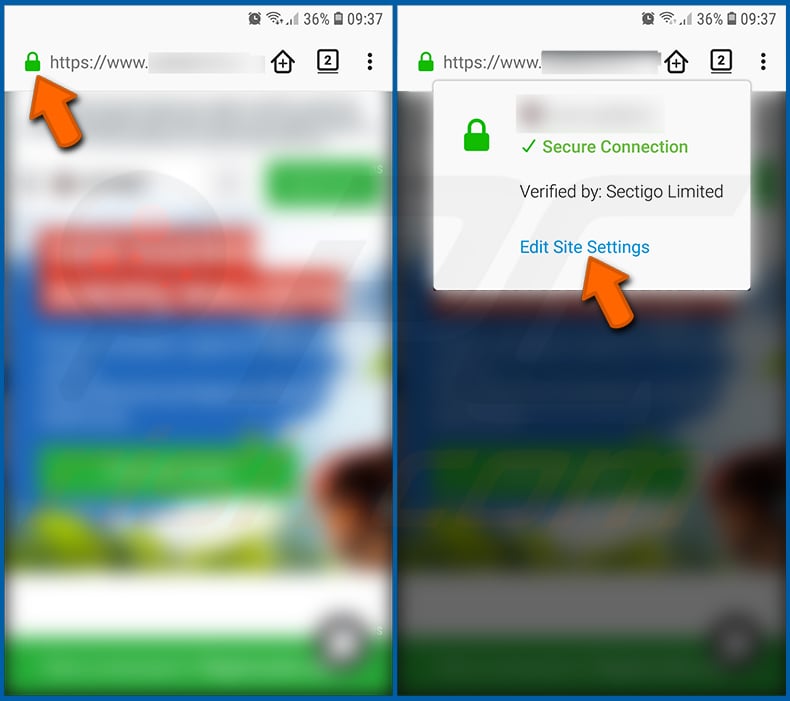
Visit the website that is delivering browser notifications, tap the icon displayed on the left of URL bar (the icon will not necessarily be a "Lock") and select "Edit Site Settings".
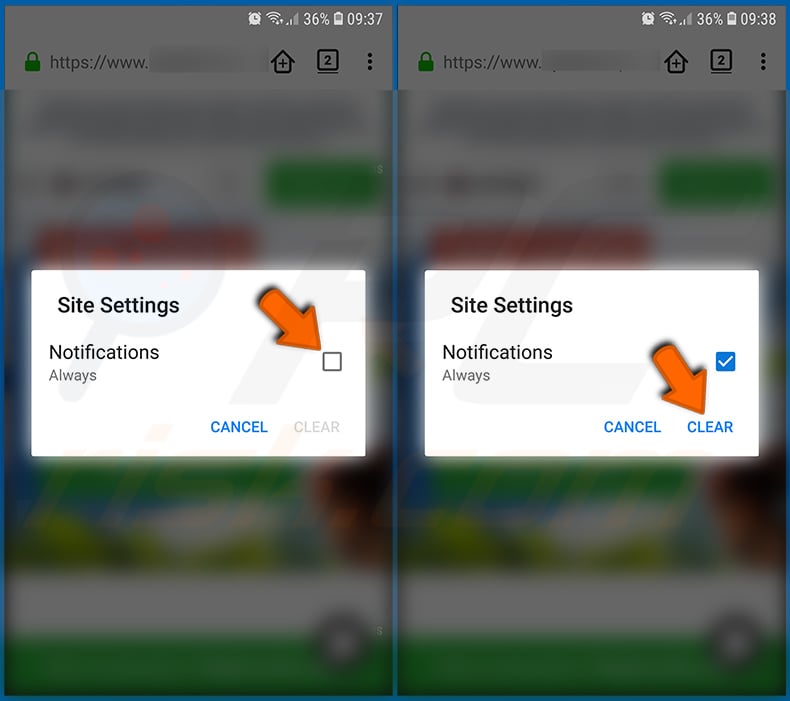
In the opened pop-up, opt-into the "Notifications" option and tap "CLEAR".
Reset the Firefox web browser:
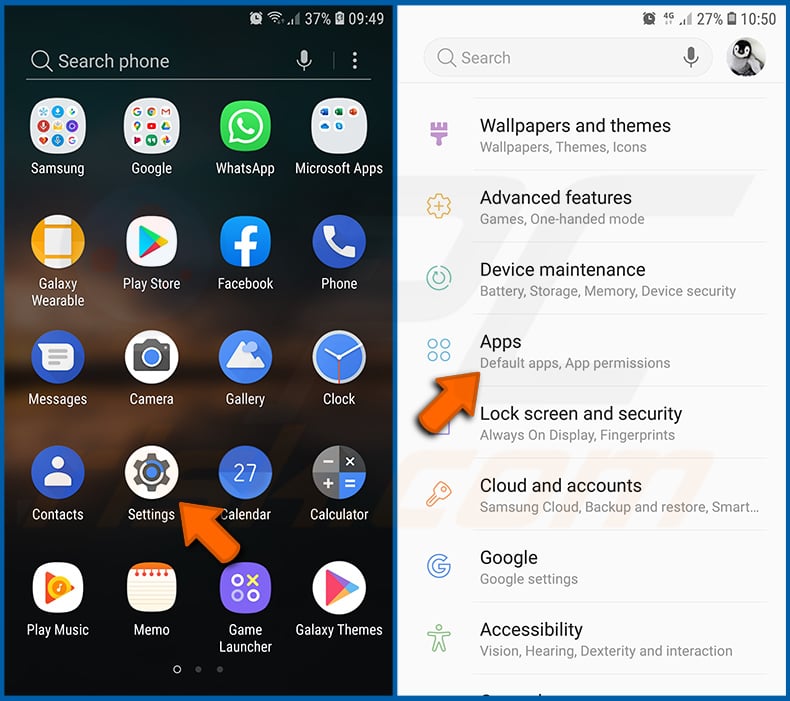
Go to "Settings", scroll down until you see "Apps" and tap it.
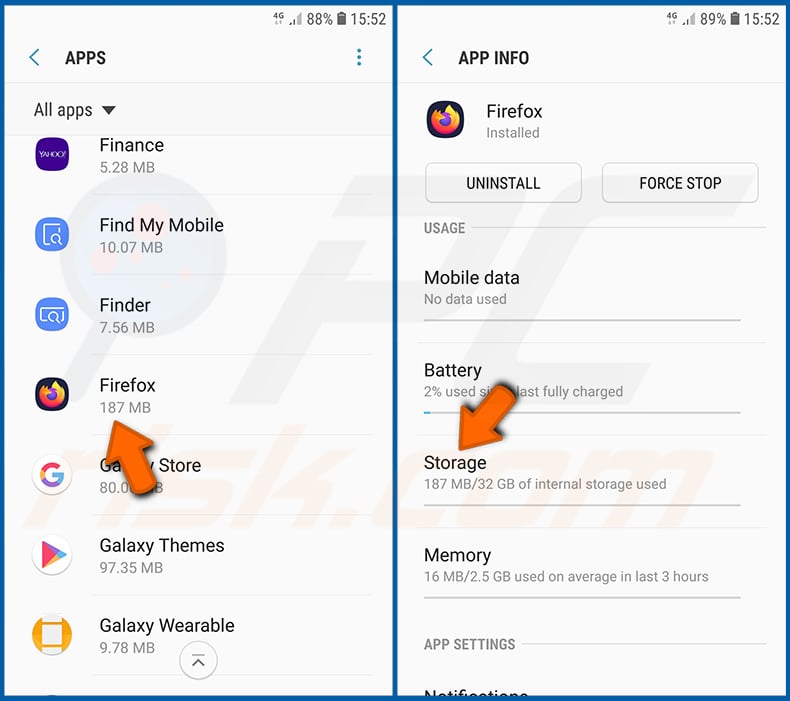
Scroll down until you find "Firefox" application, select it and tap "Storage" option.
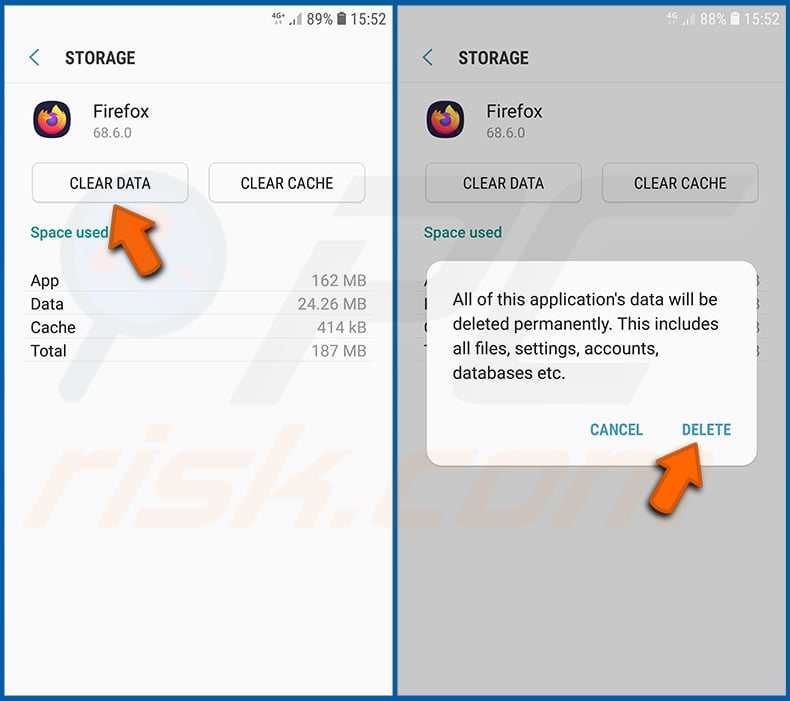
Tap "CLEAR DATA" and confirm the action by taping "DELETE". Note that resetting the browser will eliminate all data stored. Therefore, all saved logins/passwords, browsing history, non-default settings and other data will be deleted. You will also have to re-login into all websites.
Uninstall potentially unwanted and/or malicious applications:
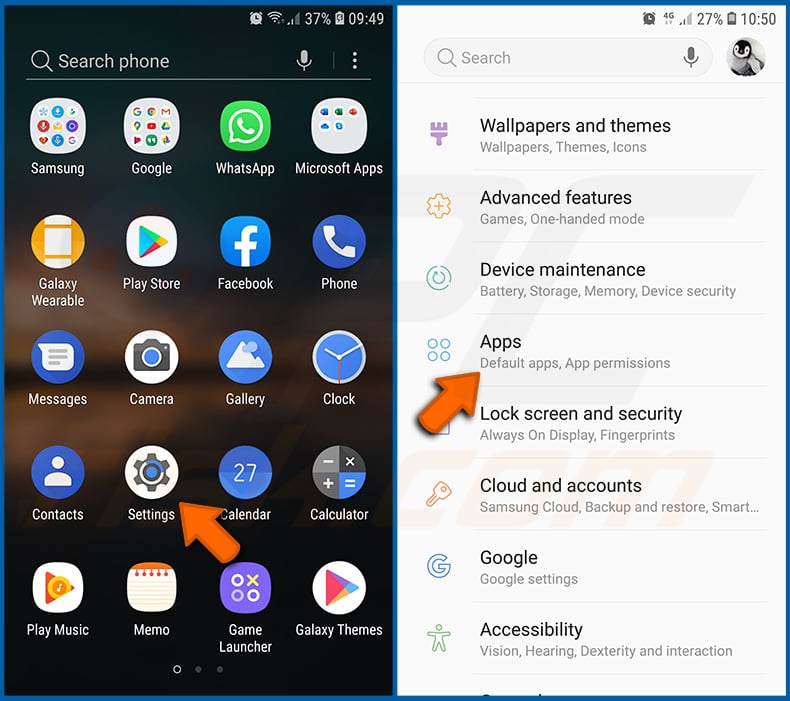
Go to "Settings", scroll down until you see "Apps" and tap it.
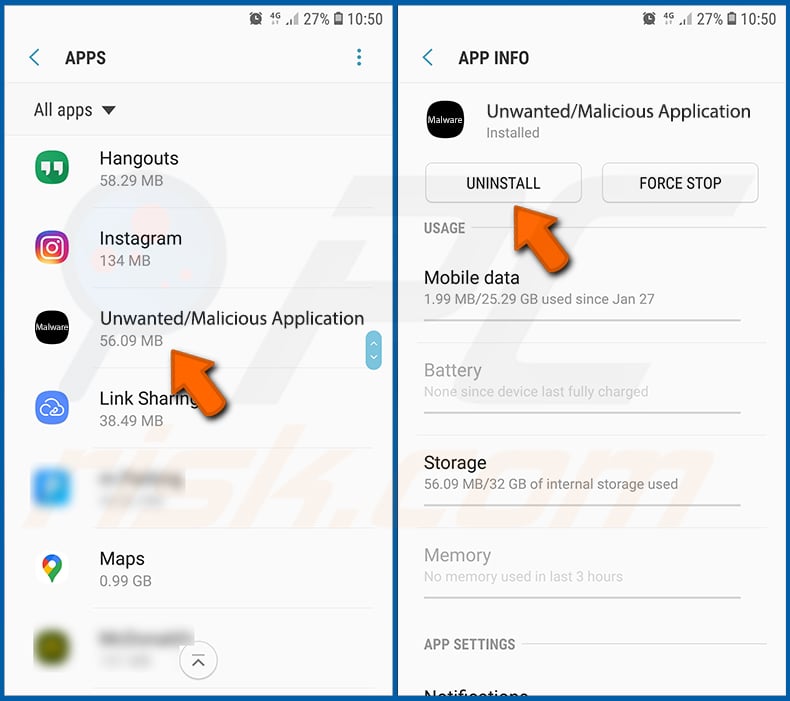
Scroll down until you see a potentially unwanted and/or malicious application, select it and tap "Uninstall". If, for some reason, you are unable to remove the selected app (e.g., you are prompted with an error message), you should try using "Safe Mode".
Boot the Android device in "Safe Mode":
"Safe Mode" in Android operating system temporarily disables all third-party applications from running. Using this mode is a good way to diagnose and solve various issues (e.g., remove malicious applications that prevent you from doing so when the device is running "normally").
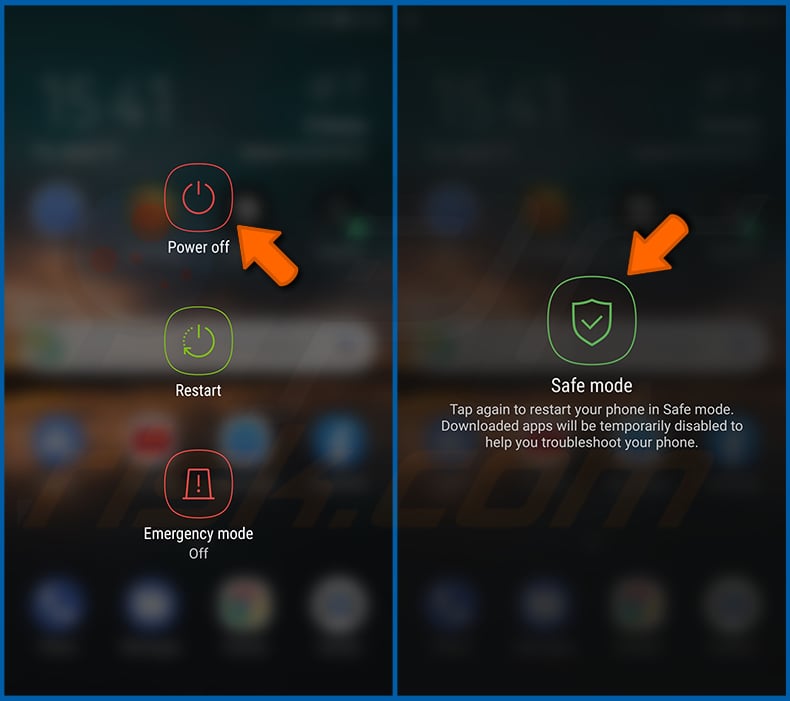
Push the "Power" button and hold it until you see the "Power off" screen. Tap the "Power off" icon and hold it. After a few seconds the "Safe Mode" option will appear and you will be able run it by restarting the device.
Check the battery usage of various applications:
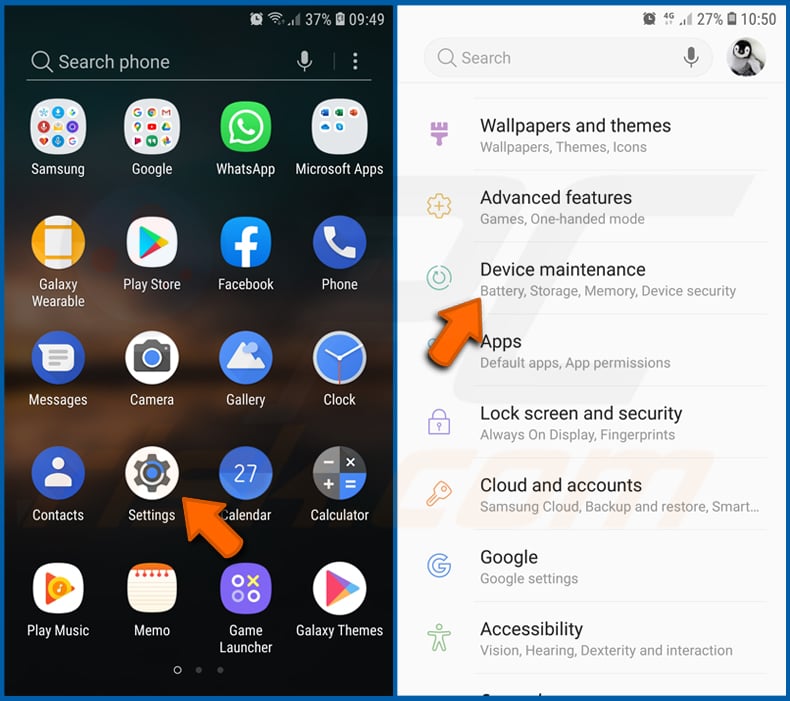
Go to "Settings", scroll down until you see "Device maintenance" and tap it.
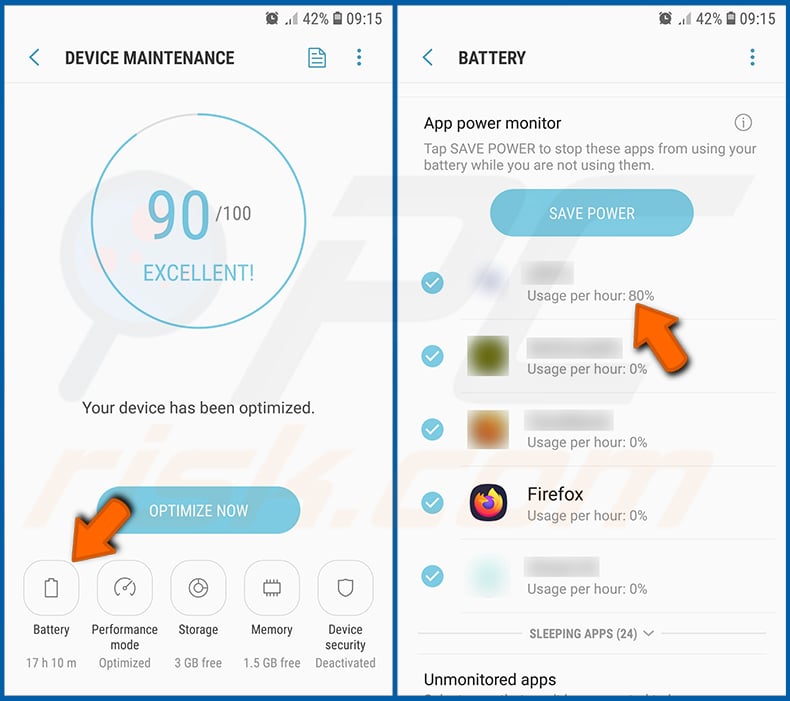
Tap "Battery" and check the usage of each application. Legitimate/genuine applications are designed to use as little energy as possible in order to provide the best user experience and to save power. Therefore, high battery usage might indicate that the application is malicious.
Check the data usage of various applications:
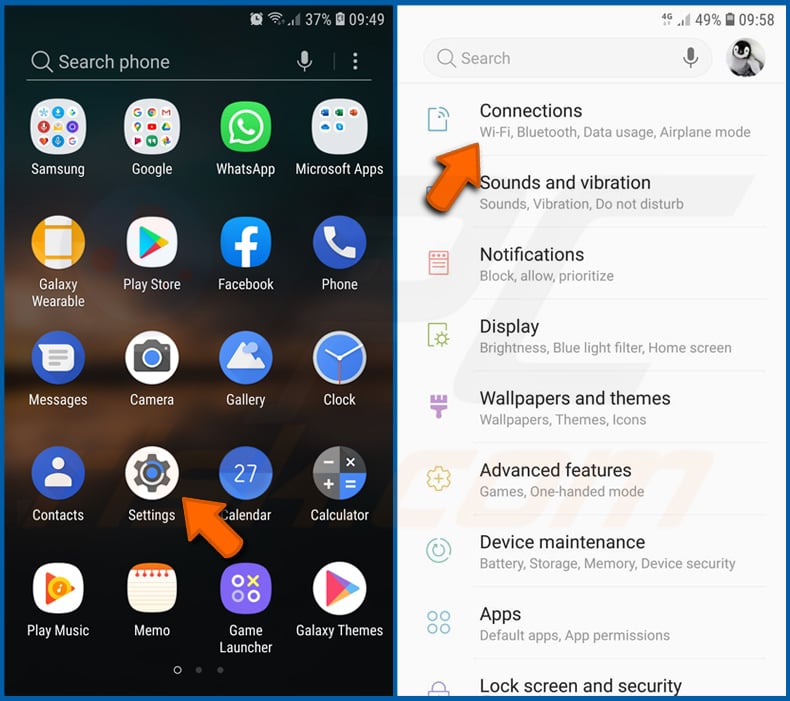
Go to "Settings", scroll down until you see "Connections" and tap it.
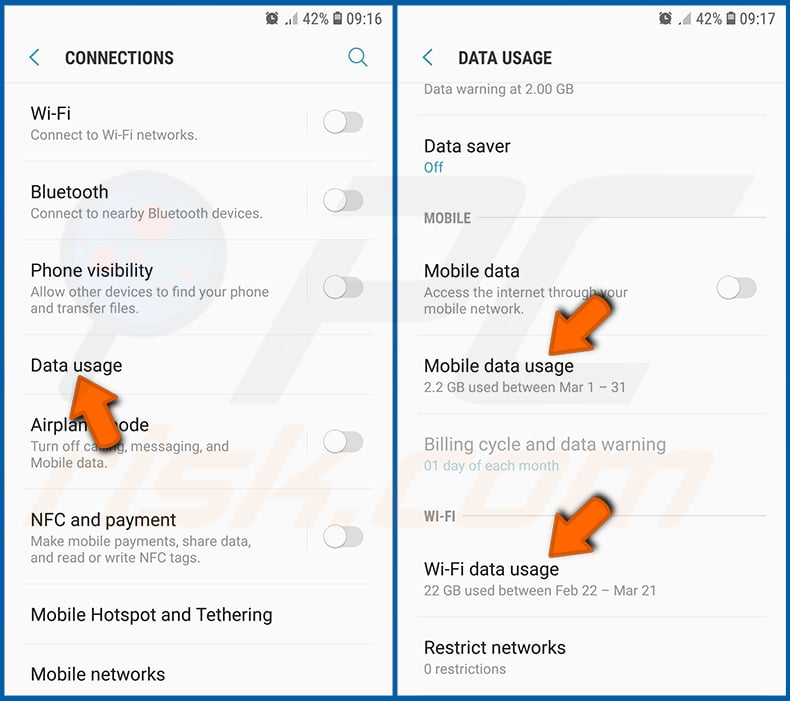
Scroll down until you see "Data usage" and select this option. As with battery, legitimate/genuine applications are designed to minimize data usage as much as possible. This means that significant data usage could indicate the presence of a malicious application.
Note that some malicious applications might be designed to operate when the device is connected to a wireless network only. For this reason, you should check both Mobile and Wi-Fi data usage.
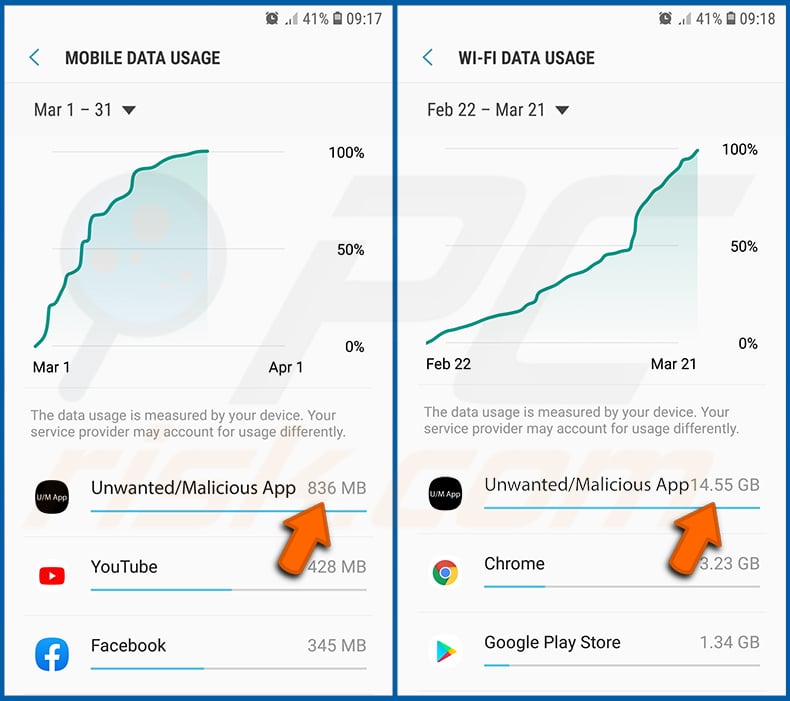
If you find an application that uses a lot of data, even though you never use it, we strongly advise you to uninstall it as soon as possible.
Install the latest software updates:
Keeping software up-to-date is a good practice for device safety. The device manufacturers are continually releasing various security patches and Android updates in order to fix errors and bugs that can be abused by cyber criminals. An outdated system is much more vulnerable, and therefore you should always be sure that your device software is up to date.
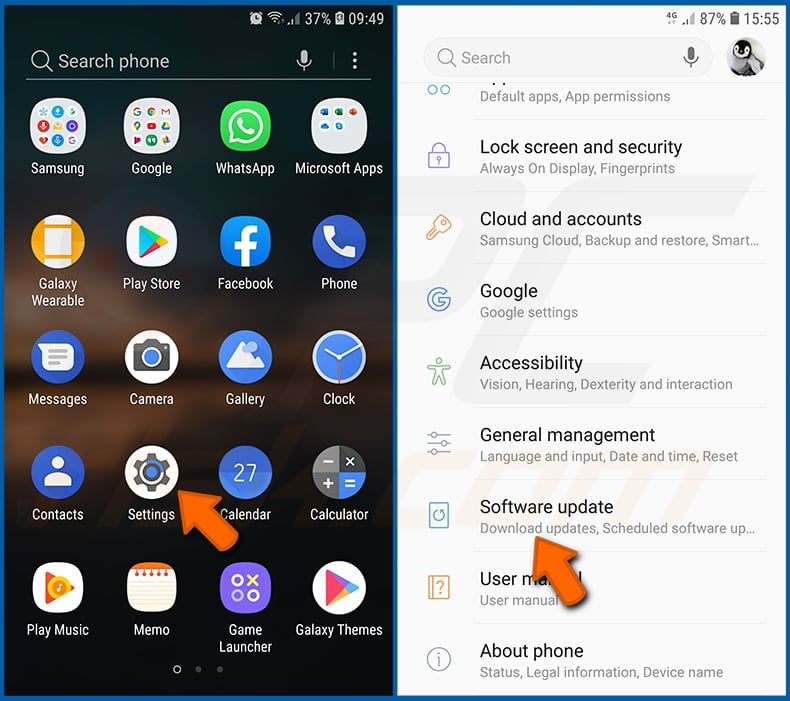
Go to "Settings", scroll down until you see "Software update" and tap it.
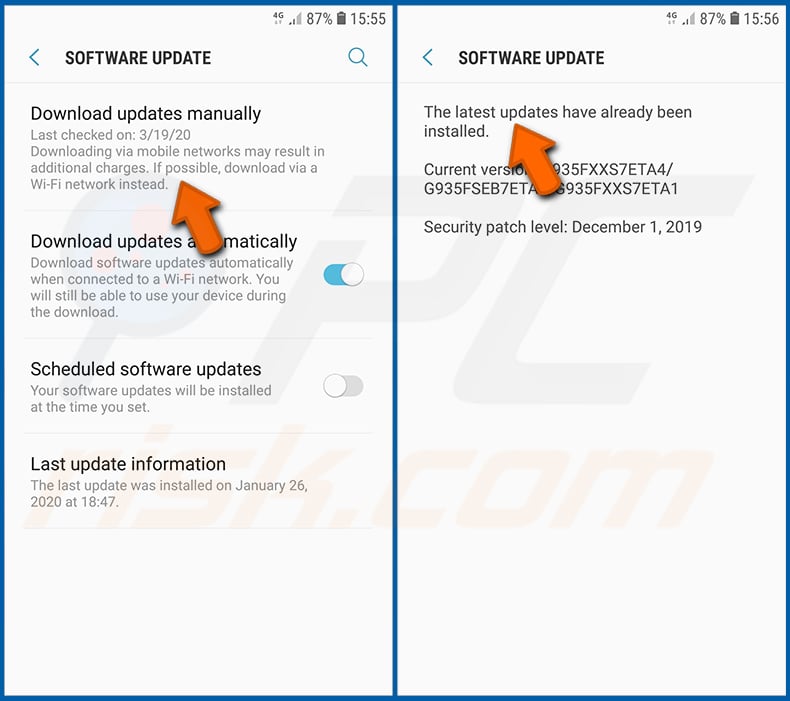
Tap "Download updates manually" and check if there are any updates available. If so, install them immediately. We also recommend that you enable the "Download updates automatically" option - this will enable the system to notify you once an update is released, and/or install it automatically.
Reset the system to its default state:
Performing a "Factory Reset" is a good way to remove all unwanted applications, restore system settings to default, and clean the device in general.
Bear in mind, however, that all data within the device will be deleted, including photos, video/audio files, phone numbers (stored within the device, not the SIM card), SMS messages, and so on. I.e., the device will be restored to its factory state.
You can also restore the basic system settings and/or simply network settings.
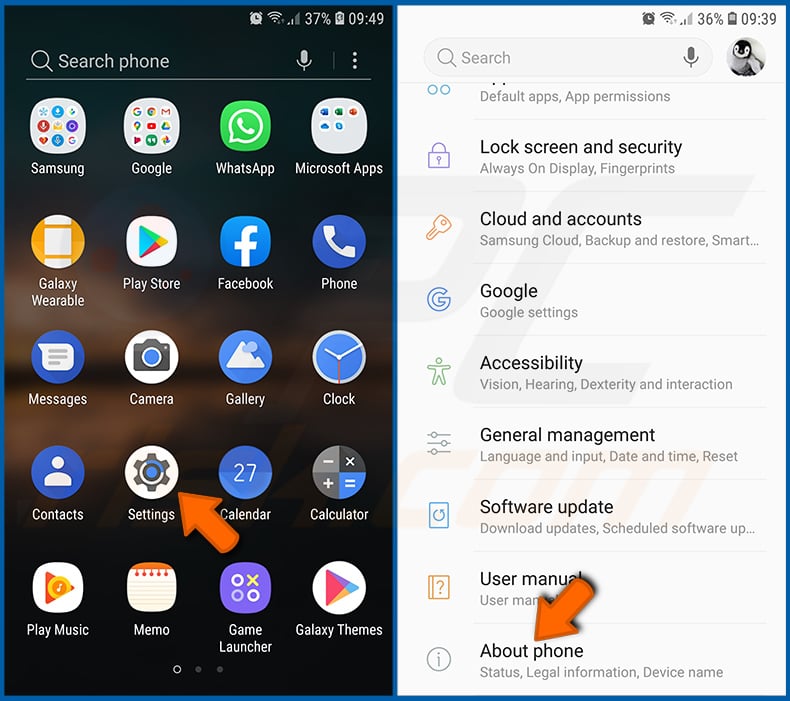
Go to "Settings", scroll down until you see "About phone" and tap it.
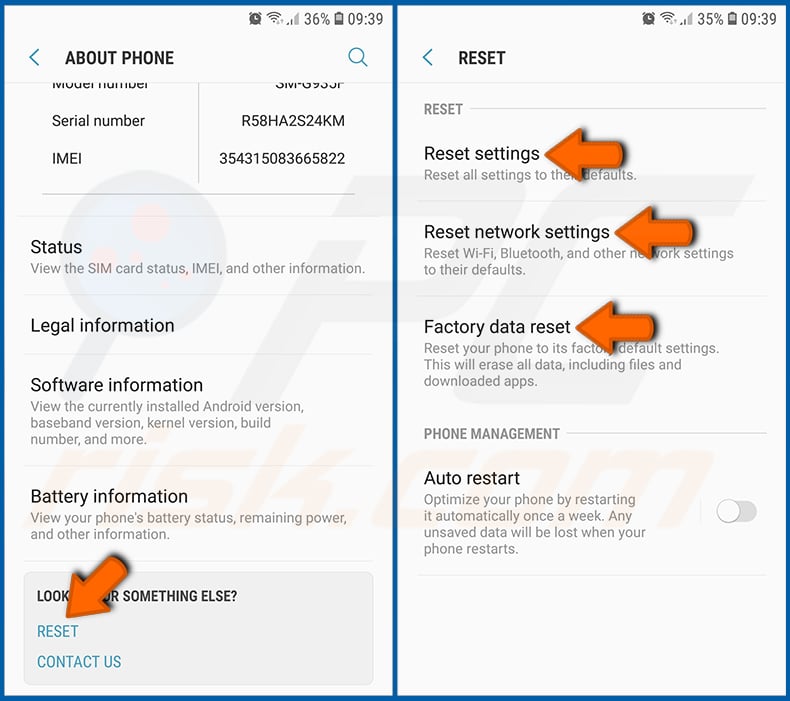
Scroll down until you see "Reset" and tap it. Now choose the action you want to perform:
"Reset settings" - restore all system settings to default;
"Reset network settings" - restore all network-related settings to default;
"Factory data reset" - reset the entire system and completely delete all stored data;
Disable applications that have administrator privileges:
If a malicious application receives administrator-level privileges, it can seriously damage the system. To keep the device as safe as possible, check which apps should have such privileges and disable those ones that do not.
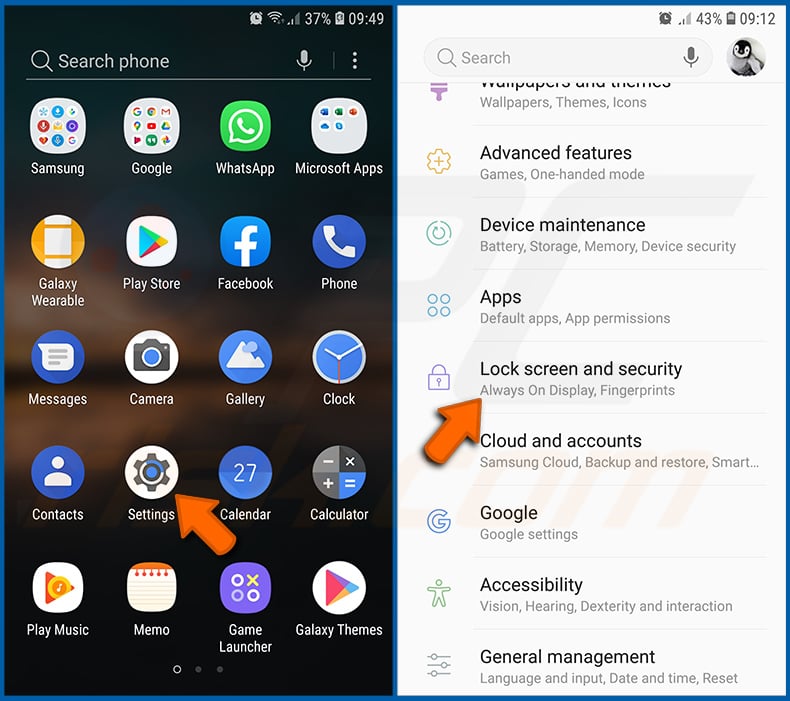
Go to "Settings", scroll down until you see "Lock screen and security" and tap it.
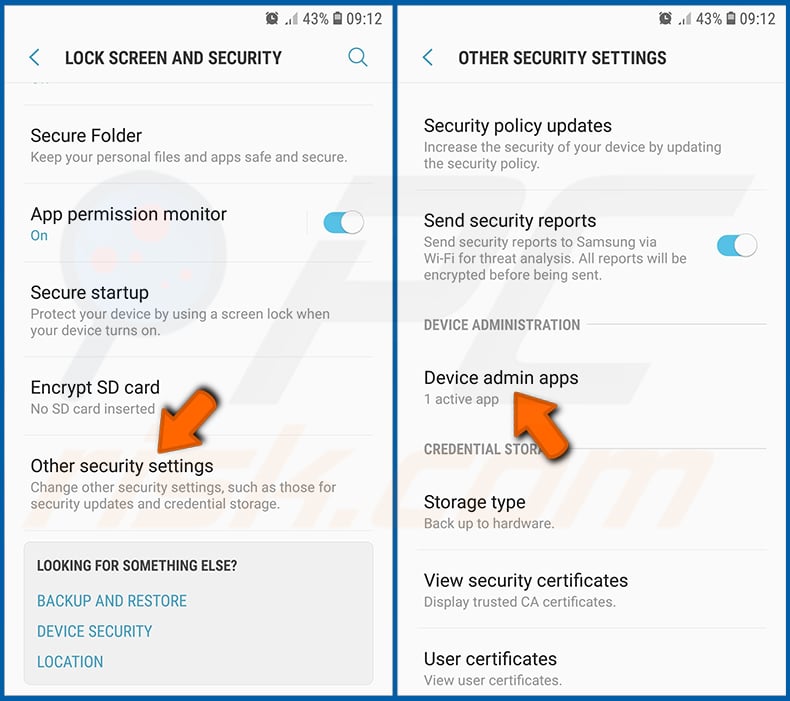
Scroll down until you see "Other security settings", tap it and then tap "Device admin apps".
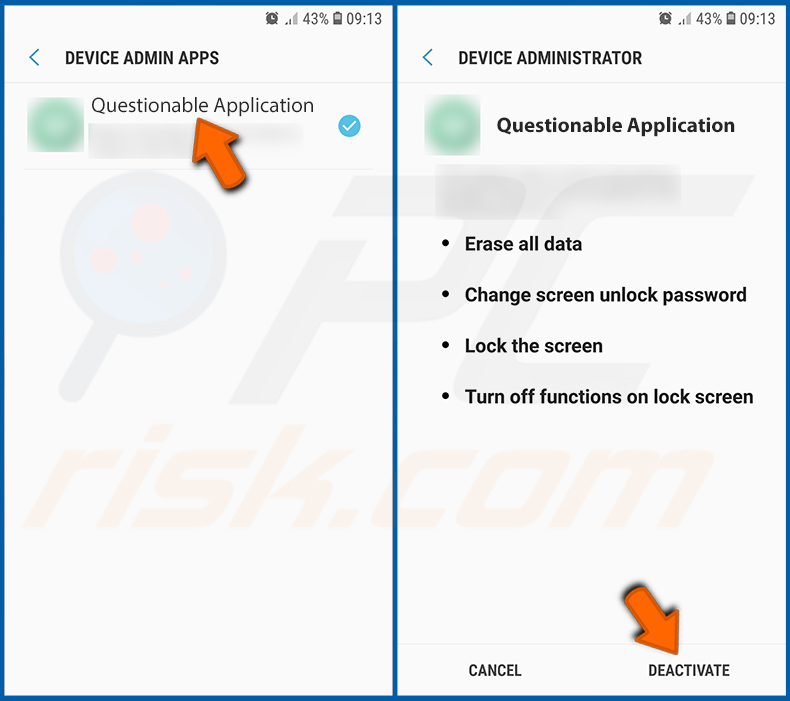
Identify applications that should not have administrator privileges, tap them and then tap "DEACTIVATE".
Share:

Tomas Meskauskas
Expert security researcher, professional malware analyst
I am passionate about computer security and technology. I have an experience of over 10 years working in various companies related to computer technical issue solving and Internet security. I have been working as an author and editor for pcrisk.com since 2010. Follow me on Twitter and LinkedIn to stay informed about the latest online security threats.
PCrisk security portal is brought by a company RCS LT.
Joined forces of security researchers help educate computer users about the latest online security threats. More information about the company RCS LT.
Our malware removal guides are free. However, if you want to support us you can send us a donation.
DonatePCrisk security portal is brought by a company RCS LT.
Joined forces of security researchers help educate computer users about the latest online security threats. More information about the company RCS LT.
Our malware removal guides are free. However, if you want to support us you can send us a donation.
Donate
▼ Show Discussion